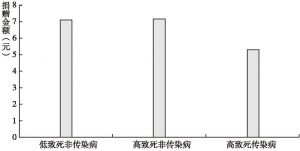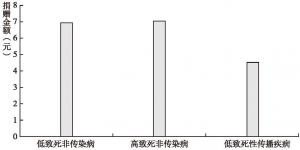摘要
根据行为免疫系统理论,个体在进化过程中发展出了抵御潜在传染病威胁的心理和行为机制,这种规避传染病的倾向可能会影响个体亲社会行为互动。本研究采用独裁者游戏范式,博弈游戏的目标对象为不同类型的疾病患者(外群体成员),验证疾病传染性与致死程度对群际亲社会行为决策的影响,并且考察状态移情在疾病类型与群际亲社会行为关系中的中介作用。结果发现:(1)相比于非传染病,个体向服务传染病患者的慈善项目捐献的金额更少;(2)状态移情在不同类型疾病条件下亲社会行为表现中起中介作用:以低致死非传染病为控制组,低致死性传播疾病负向预测状态移情,从而降低亲社会行为表现,而高致死非传染病正向预测状态移情,表现出的亲社会行为更强烈。上述结果表明,感知到强烈的潜在风险可能会触发行为免疫系统,进一步影响后续的互动。
- 陈世平、揭满、王晓庄,2017,《术语和俗语对疾病风险认知的影响》,《心理科学》第5期,第1260~1265页。
- 温忠麟、叶宝娟,2014,《中介效应分析:方法和模型发展》,《心理科学进展》第5期,第731~745页。
- 吴宝沛、张雷,2011,《疾病的心理防御:人类如何应对病菌威胁》,《心理科学进展》第3期,第410~419页。
- 岳童、黄希庭、刘光远,2018,《催产素对共情反应的影响及其作用机制》,《心理科学进展》第3期,第442~453页。
- Barth,A.,Schmalzle,R.,Renner,B.,& Schupp,H.T.(2013).Neural correlates of risk perception:HIV vs.leukemia.7,166.
- Brethel-Haurwitz,K.M.,Cardinale,E.M.,Vekaria,K.M.,Robertson,E.L.,Walitt,B.,VanMeter,J.W.,& Marsh,A.A.(2018).Extraordinary altruists exhibit enhanced self-other overlap in neural responses to distress.29,1631-1641.
- Buck,R.(2002).The genetics and biology of true love:Prosocial biological affects and the left hemisphere. 109,739-744.
- Carlson,R.W.,Aknin,L.B.,& Liotti,M.(2016).When is giving an impulse? An ERP investigation of intuitive prosocial behavior.11,1121-1129.
- Cottrell,C.A.,& Neuberg,S.L.(2005).Different emotional reactions to different groups:A sociofunctional threat-based approach to “prejudice”.,88,770-789.
- Dijksterhuis,A.(2004).Think different:The merits of unconscious thought in preference development and decision making.,87,586-598.
- Dijksterhuis,A.,Bos,M.W.,Nordgren,L.F.,& van Baaren,R.B.(2006).On making the right choice:The deliberation-without-attention effect.,311,1005-1007.doi:10.1126/science.1121629.
- Duncan,L.A.,& Schaller,M.(2009).Prejudicial attitudes toward older adults may be exaggerated when people feel vulnerable to infectious disease:Evidence and implications.9,97-115.
- Ein-Gar,D.,& Levontin,L.(2013).Giving from a distance:Putting the charitable organization at the center of the donation appeal.23,197-211.
- Faulkner,J.,Schaller,M.,Park,J.H.,& Duncan,L.A.(2004).Evolved disease-avoidance mechanisms and contemporary xenophobic attitudes. & 7,333-353.
- Gaertner,S.L.,Dovidio,J.F.,Rust,M.C.,Nier,J.A.,Banker,B.S.,Ward,C.M.,Mottola,G.R.,& Houlette,M.(1999).Reducing intergroup bias:Elements of intergroup cooperation.76,388-402.
- Goel,V.,Buchel,C.,Frith,C.,& Dolan,R.J.(2000).Dissociation of mechanisms underlying syllogistic reasoning.12,504-514.
- Gutsell,J.N.,& Inzlicht,M.(2012).Intergroup differences in the sharing of emotive states:Neural evidence of an empathy gap.e,7,596-603.
- Haidt,J.,McCauley,C.,& Rozin,P.(1994).Individual differences in sensitivity to disgust:A scale sampling seven domains of disgust elicitors. 16,701-713.
- Hayes,A.F.,& Preacher,K.J.(2014).Statistical mediation analysis with a multicategorical independent variable.67,451-470.
- Hopkins,N.,Reicher,S.,Harrison,K.,Cassidy,C.,Bull,R.,& Levine,M.(2007).Helping to improve the group stereotype:On the strategic dimension of prosocial behavior.33,776-788.
- Jackson,P.L.,Brunet,E.,Meltzoff,A.N.,& Decety,J.(2006).Empathy examined through the neural mechanisms involved in imagining how I feel versus how you feel pain.44,752-761.
- Kahneman,D.,& Tversky,A.(1973).On the psychology of prediction. 80,237-251.
- Kupfer,T.R.(2018).Why are injuries disgusting? Comparing pathogen avoidance and empathy accounts.18,959-970.
- Li,X.,Liu,Y.,Luo,S.,Wu,B.,Wu,X.,& Han,S.(2015).Mortality salience enhances racial in-group bias in empathic neural responses to others' suffering.118,376-385.
- Maner,J.K.,& Gailliot,M.T.(2007).Altruism and egoism:Prosocial motivations for helping depend on relationship context. 37,347-358.
- Masten,C.L.,Morelli,S.A.,& Eisenberger,N.I.(2011).An fMRI investigation of empathy for “social pain” and subsequent prosocial behavior.55,381-388.
- Mathur,V.A.,Harada,T.,Lipke,T.,& Chiao,J.Y.(2010).Neural basis of extraordinary empathy and altruistic motivation.51,1468-1475.
- Meyer,M.L.,Masten,C.L.,Ma,Y.,Wang,C.,Shi,Z.,Eisenberger,N.I.,& Han,S.(2013).Empathy for the social suffering of friends and strangers recruits distinct patterns of brain activation. 8,446-454.
- Mifune,N.,Hashimoto,H.,& Yamagishi,T.(2010).Altruism toward in-group members as a reputation mechanism.31,109-117.
- Miller,S.L.,& Maner,J.K.(2012).Overperceiving disease cues:The basic cognition of the behavioral immune system.102,1198-1213.
- Navarrete,C.D.,& Fessler,D.M.T.(2006).Disease avoidance and ethnocentrism:The effects of disease vulnerability and disgust sensitivity on intergroup attitudes.27,270-282.
- Oaten,M.,Stevenson,R.J.,& Case,T.I.(2009).Disgust as a disease-avoidance mechanism.135,303-321.
- Olsson,M.J.,Lundstrom,J.N.,Kimball,B.A.,Gordon,A.R.,Karshikoff,B.,Hosseini,N.,...,& Lekander,M.(2014).The scent of disease:Human body odor contains an early chemosensory cue of sickness.25,817-823.
- Park,J.H.,Schaller,M.,& Crandall,C.S.(2007).Pathogen-avoidance mechanisms and the stigmatization of obese people. 28,410-414.
- Petersen,M.B.(2017).Healthy out-group members are represented psychologically as infected in-group members. 28,1857-1863.
- Peterson,J.C.,Gonzalez,F.J.,& Schneider,S.P.(2017).Effects of disease salience and xenophobia on support for humanitarian aid.36,17-36.
- Preston,S.D.,& de Waal,F.B.M.(2002).Empathy:Its ultimate and proximate bases.25,1-72.
- Rameson,L.T.,Morelli,S.A.,& Lieberman,M.D.(2011).The neural correlates of empathy:Experience,automaticity,and prosocial behavior.24,235-245.
- Renner,B.,Schmalzle,R.,& Schupp,H.T.(2012).First impressions of HIV risk:It takes only milliseconds to scan a stranger.,7,e30460.
- Rosen,J.B.,Brand,M.,& Kalbe,E.(2016).Empathy mediates the effects of age and sex on altruistic moral decision making. 10,67.
- Schaller,M.,& Park,J.H.(2011).The behavioral immune system (and why it matters).20,99-103.
- Singer,T.,Critchley,H.D.,& Preuschoff,K.(2009).A common role of insula in feelings,empathy and uncertainty. 13,334-340.
- Singer,T.,Seymour,B.,O'Doherty,J.,Kaube,H.,Dolan,R.J.,& Frith,C.D.(2004).Empathy for pain involves the affective but not sensory components of pain.303,1157-1162.
- Steinkopf,L.(2016).Disgust,empathy,and care of the sick:An evolutionary perspective.3,149-158.
- Terrizzi,J.A.,Shook,N.J.,& McDaniel,M.A.(2013).The behavioral immune system and social conservatism:A meta-analysis.34,99-108.
- Tinghög,G.,Anderson,D.,Bonn,C.,Johansson,M.,Kirchler,M.,Koppel,L.,& Västfjäll,D.(2016).Intuition and moral decision-making—The effect of time pressure and cognitive load on moral judgment and altruistic behavior.11,e0164012.
- Tversky,A.,& Kahneman,D.(1983).External versus intuitive reasoning:The conjunction fallacy in probability judgment.90,293-315.
- Tybur,J.M.,Lieberman,D.,Kurzban,R.,& DeScioli,P.(2013).Disgust:Evolved function and structure.120,65-84.
- Zarolia,P.,Weisbuch,M.,& McRae,K.(2016).Influence of indirect information on interpersonal trust despite direct information.112,39-57.




